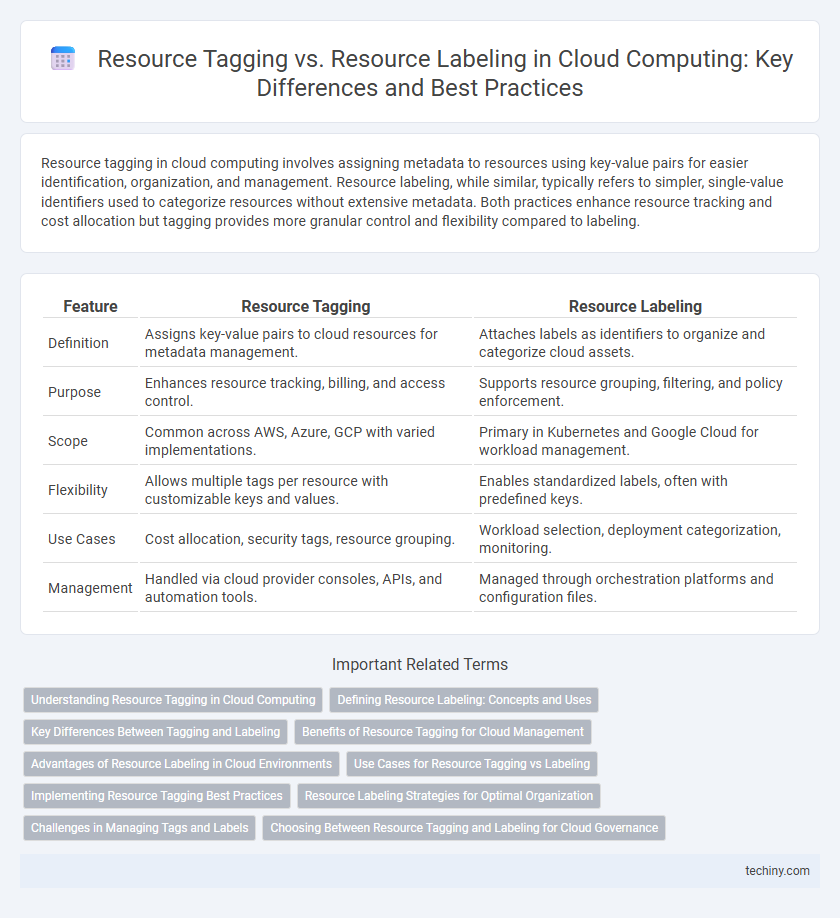Resource tagging in cloud computing involves assigning metadata to resources using key-value pairs for easier identification, organization, and management. Resource labeling, while similar, typically refers to simpler, single-value identifiers used to categorize resources without extensive metadata. Both practices enhance resource tracking and cost allocation but tagging provides more granular control and flexibility compared to labeling.
Table of Comparison
| Feature | Resource Tagging | Resource Labeling |
|---|---|---|
| Definition | Assigns key-value pairs to cloud resources for metadata management. | Attaches labels as identifiers to organize and categorize cloud assets. |
| Purpose | Enhances resource tracking, billing, and access control. | Supports resource grouping, filtering, and policy enforcement. |
| Scope | Common across AWS, Azure, GCP with varied implementations. | Primary in Kubernetes and Google Cloud for workload management. |
| Flexibility | Allows multiple tags per resource with customizable keys and values. | Enables standardized labels, often with predefined keys. |
| Use Cases | Cost allocation, security tags, resource grouping. | Workload selection, deployment categorization, monitoring. |
| Management | Handled via cloud provider consoles, APIs, and automation tools. | Managed through orchestration platforms and configuration files. |
Understanding Resource Tagging in Cloud Computing
Resource tagging in cloud computing involves assigning metadata in the form of key-value pairs to cloud resources, enabling efficient organization, management, and automation across complex environments. Unlike resource labeling, which often provides simple categorizations, resource tagging supports detailed, customizable metadata that improves resource tracking, cost allocation, and policy enforcement. Effective resource tagging enhances cloud governance and operational efficiency by facilitating granular control and streamlined automation.
Defining Resource Labeling: Concepts and Uses
Resource labeling in cloud computing involves assigning descriptive metadata to cloud assets, enabling efficient organization, categorization, and retrieval of resources. Labels usually consist of key-value pairs that provide context such as environment type, project ownership, or compliance status, enhancing automation and cost management. This systematic identification supports governance and operational workflows by simplifying resource tracking and policy enforcement across multi-cloud environments.
Key Differences Between Tagging and Labeling
Resource tagging in cloud computing involves assigning metadata as key-value pairs to resources for better organization, cost allocation, and management, whereas resource labeling typically uses simpler, more human-readable identifiers or categories to group resources. Tags provide granular, customizable attributes crucial for automation, access control, and billing, while labels often focus on easier resource grouping and filtering in user interfaces. The key difference lies in tags offering flexible, machine-readable data essential for operational workflows, whereas labels emphasize straightforward categorization for quick identification.
Benefits of Resource Tagging for Cloud Management
Resource Tagging in cloud computing streamlines asset organization by assigning metadata that enhances searchability, cost allocation, and security management. Tags enable automated policy enforcement and efficient resource grouping across diverse cloud environments, improving governance and operational agility. Effective tagging reduces overhead costs by providing granular visibility into resource utilization and facilitating accurate billing and compliance tracking.
Advantages of Resource Labeling in Cloud Environments
Resource labeling in cloud environments enhances resource organization by enabling more granular metadata assignment, which improves searchability and automated management. Labels support dynamic categorization across multiple dimensions such as project, environment, and cost center, facilitating precise cost allocation and governance. This flexibility surpasses traditional tagging by integrating seamlessly with cloud-native automation and monitoring tools.
Use Cases for Resource Tagging vs Labeling
Resource tagging in cloud computing enables precise cost allocation, security policy enforcement, and automated resource management by attaching metadata to resources, making it ideal for environments needing granular governance and billing transparency. Resource labeling, often used for categorization and organizing resources by attributes like environment or project, supports simplified search and filtering but lacks the policy-driven capabilities of tagging. Use cases for tagging include compliance auditing, access control, and lifecycle management, whereas labeling is primarily suited for resource grouping and basic organization.
Implementing Resource Tagging Best Practices
Implementing resource tagging best practices in cloud computing enhances asset management by associating metadata with resources, enabling efficient cost allocation, security tracking, and automation. Tags, which are key-value pairs, offer more granular control compared to labels, supporting complex queries and policy enforcement across multi-cloud environments. Adopting consistent naming conventions, leveraging automated tagging tools, and regularly auditing tag compliance ensures improved governance and operational efficiency.
Resource Labeling Strategies for Optimal Organization
Resource labeling strategies enhance cloud resource organization by applying consistent, descriptive tags that improve asset tracking and cost management. Implementing hierarchical and multi-dimensional labels enables granular visibility across teams and projects, optimizing resource allocation and security policies. Leveraging automated labeling tools ensures accuracy and scalability in maintaining structured cloud environments.
Challenges in Managing Tags and Labels
Managing resource tagging and labeling in cloud computing presents significant challenges, including inconsistency in naming conventions, which leads to difficulties in resource identification and tracking. The lack of standardized schemas increases the risk of tag sprawl, making automation and cost allocation less effective. Ensuring governance and enforcing policies across diverse teams and cloud environments complicates consistent application and maintenance of tags and labels.
Choosing Between Resource Tagging and Labeling for Cloud Governance
Resource tagging and resource labeling both play critical roles in cloud governance by enhancing resource organization and management. Tagging uses key-value pairs to provide flexible metadata that supports cost tracking, access control, and automation, whereas labeling typically involves predefined categories emphasizing standardized classification. Choosing between tagging and labeling depends on governance requirements: tagging offers greater customization for complex environments, while labeling ensures consistency and simplicity in resource categorization.
Resource Tagging vs Resource Labeling Infographic

 techiny.com
techiny.com